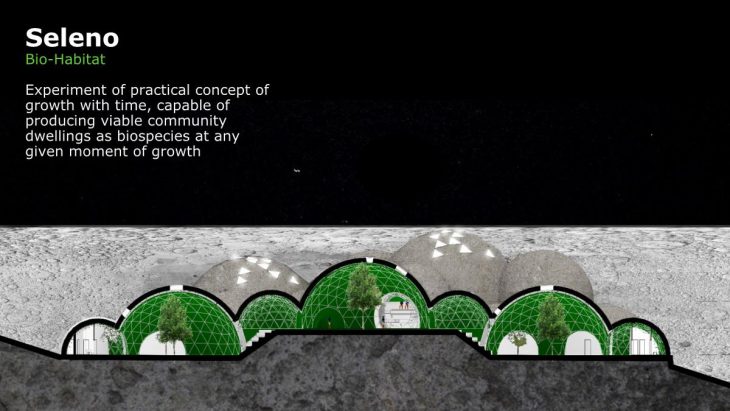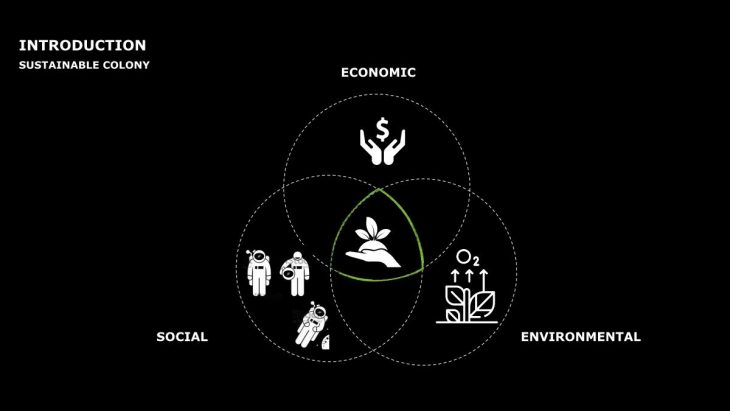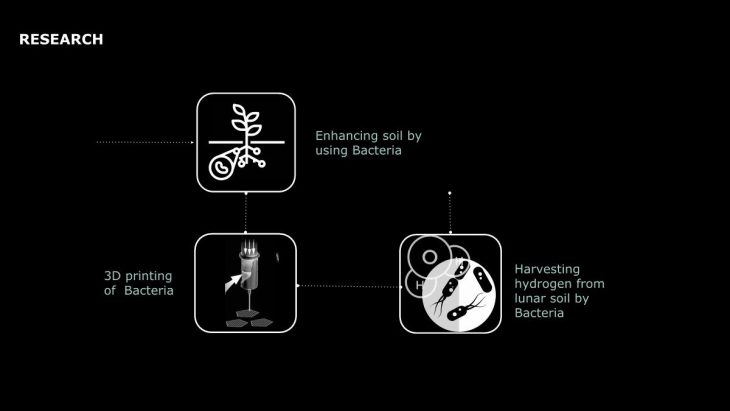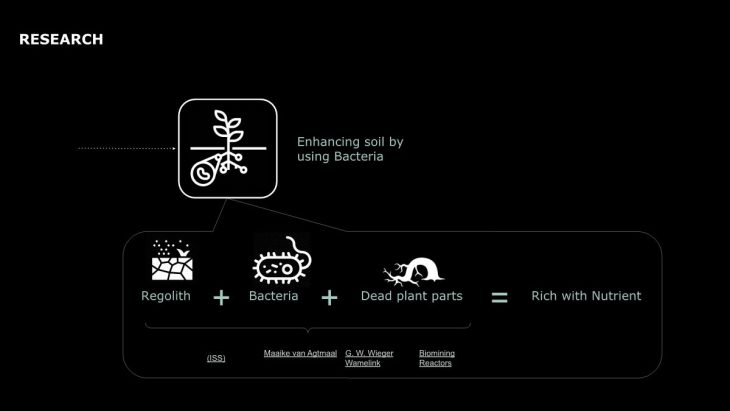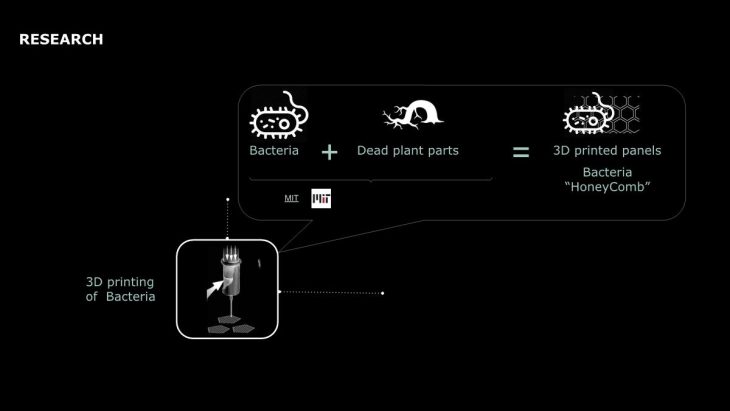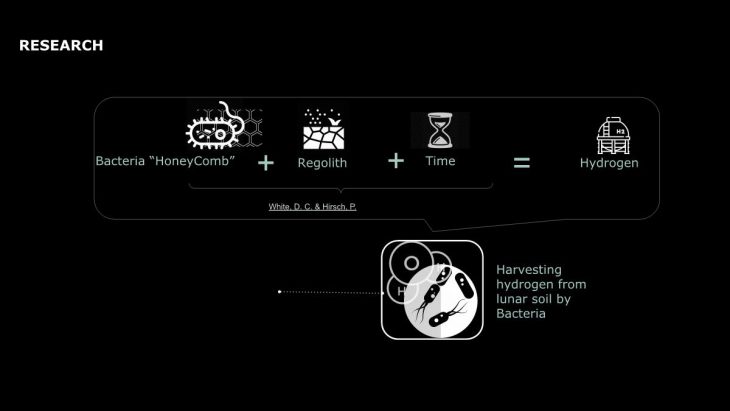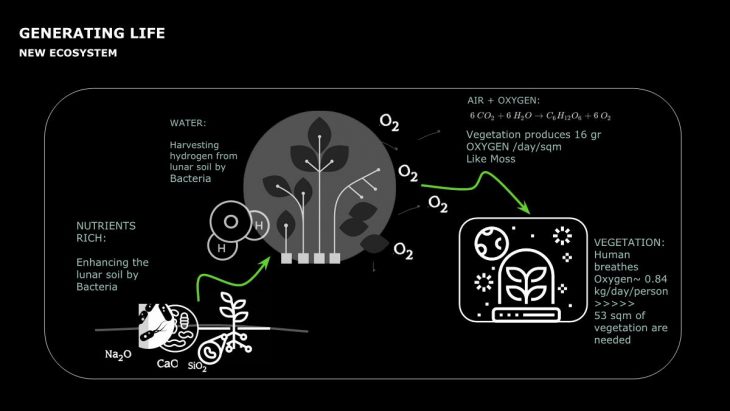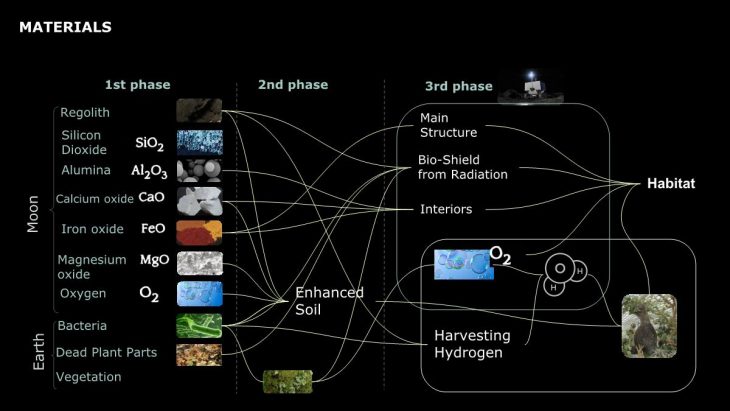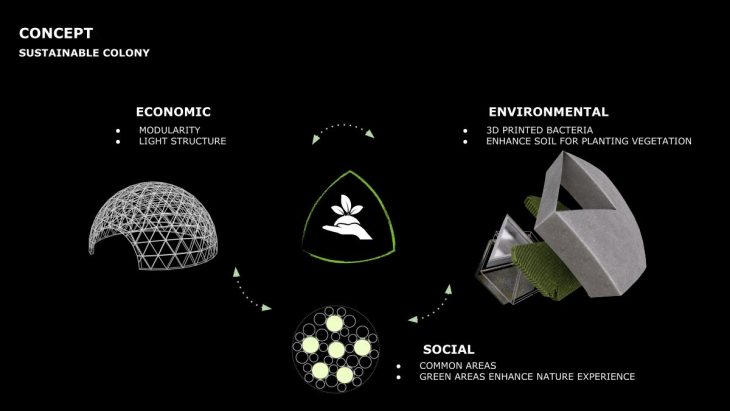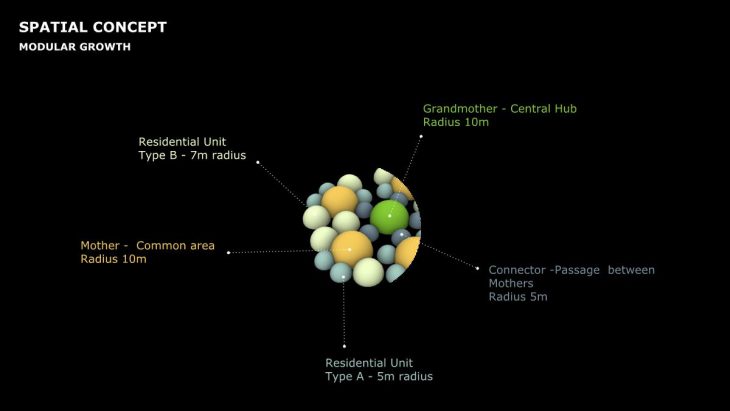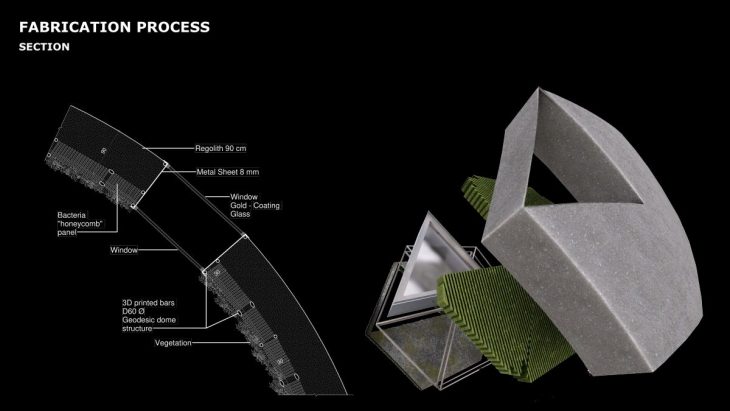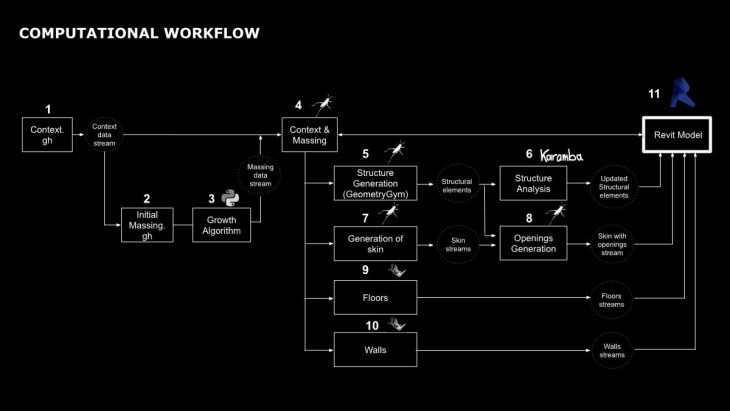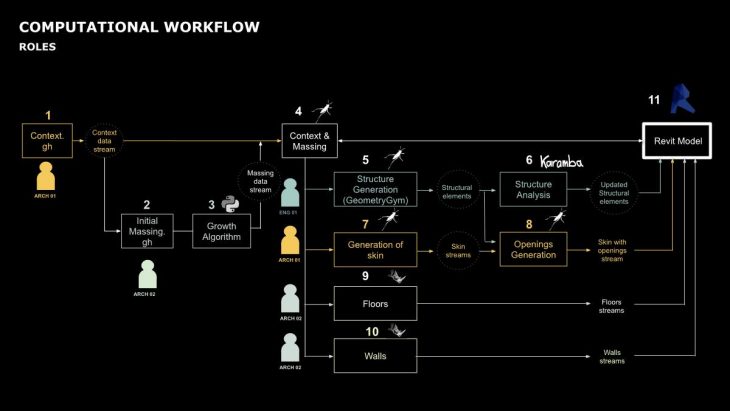Seleno Bio-Habitat is an experiment of practical concept of growth with time, capable of producing viable community dwellings as biospecies at any given moment of growth. We believe that Seleno Bio-Habitat might evolve in the future and create successive descendant habitats that variant from the ancestors. It is a semi-evolution, where generations might be varied and modified until an optimum is obtained.
Seleno Bio-Habitat addresses challenging questions relate to a sustainable blend between what is economic, environmental, and social. Addressing questions about self-fulfillment, community goals, sustained Economics that allow growth, research, and development. Questions on colony’s natural/circular ecosystem, and resource optimization. And questions on Bio-conditions, Self-sufficient to sustain life, Sense of community, and the Psychological need for green space
Our team came to the conclusion that at the first step, we are sending Bacteria to colonize the moon. Searching for a technology that might generate life on the moon, a life that can create an equilibrium and progress, we found some emergent cutting-edge research and experiments. The first research is about a successful experiment on enhancing and enrichment of the Regolith with Nutrients by using Bacteria
The first research is about successful experiments on enhancing and enrichment of the Regolith with Nutrients [(ISS), Maaike van Agtmaal, G. W. Wieger Wamelink, Biomining Reactors]. The most useful for the Seleno Bio-Habitat is the experiment that examined the enrichment of the Regolith simulant using Bacteria and dead plant parts, where the Nutrients in the dead plant parts will be released to the soil using bacteria to break down the dead plant material first. According to the ISS team, bacteria could one day be used to break rocks down into the soil for growing crops or to provide minerals for life support systems that produce air and water.
The second research is 3D printing Bacteria as a living organism combined with another medium [ MIT ]. In our experiment, we will 3D print Bacteria with the dead plant parts into HoneyComb panel shapes, in order to use them in the construction.
The third research is assuming that Bacteria offer particularly adaptable mechanisms of harvesting lunar hydrogen [White, D. C. & Hirsch, P.].
Our proposal for generating new life on the moon starts with enhancing and enriching the Regolith with Nutrients using Bacteria and extracting needed minerals, such as oxygen. The necessary bacterial cultures can be brought from Earth in the form of either lyophilized or deeply-frozen strains [White, D. C. & Hirsch, P.]. Next step will be harvesting Hydrogen using Bacteria in order to produce water H2O, which will allow planting larger green areas and vegetation, such as Moss. The Moss has great qualities and capabilities in producing Oxygen, each sqm vegetation of Moss can produce 16 gr Oxygen per day. Consequently, in this ecosystem, we need almost 53 sqm of vegetation/Moss per person to provide daily needs of Oxygen, according to NASA tables ( 0.84 kg of Oxygen Human daily consumption).
This map shows the use of different materials whether they are extracted from lunar soil (bacteria mining) or shipped from the earth. It also shows the different phases of exploiting the different resources.
Following this, our concept for a sustainable colony on the moon will be an execution of the economic, environmental, and social blend. We looked for modularity and lightness in structure, breathing skin system, and growing organization that preserves community values and common areas.
The video shows how the system works, the Geodesic structure will be a doubled system that can have the 3D printed Bacteria panels inside. The lunar soil will cover the structure with the panels to produce a bio-shield. The 3d printed bacteria panels will come to interact with the soil and then enhance its qualities. The inner side of the structure will be planted with moss.
Our spatial concept is based on the idea of modular growth. In the project we are using the following modules:
- Residential units of two sizes, radius 5m, and 7m are connected with a common area we call a mother.
- Mothers have a radius of 10m and are connected with each other using a connector module of radius 5m. One of the mothers acts as a central hub and connects to the underground station of the lunar network system.
During the design process, we thought about the initial settlement of around ~100 people as well as the possibility of the future expansion of the colony. To accommodate this, we developed a growth algorithm that adds new clusters of mothers and the units and allows for growth outside of the initial boundary.
The initial settlement will start from a central hub including the lunar network system. Then through connector units, it will connect to another mother that will be a host for multiple residential units. In the future, some of the smaller units will become connectors units that will allow access to the new clusters. This is the initial configuration, and then we will zoom out to look at the future growth scenario.
In each cluster, two smaller residential units will be designated as a future connector. When there is a need to grow in a certain direction, a new mother will be added, and new residential units will be populated around it. This would allow flexibility of the future growth of the colony
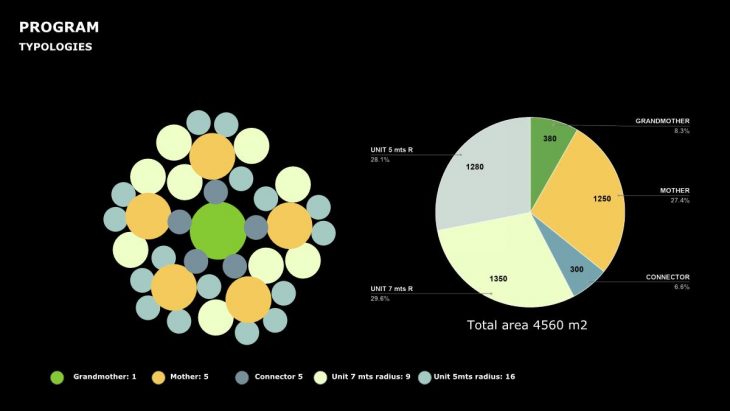
The pie chart shows the total floor area (4.560 m2) of the initial configuration and the percentages of the discussed modules.
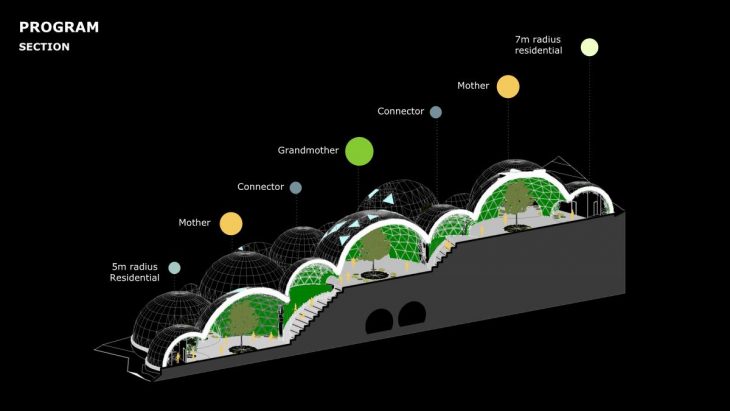
This section shows the distribution of the program for each of the modules.
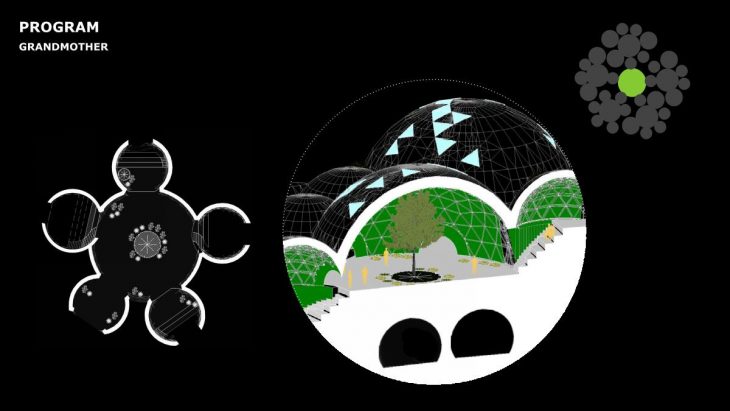
Starting from the grandmother- here is the central hub with the connection to the underground tunnel
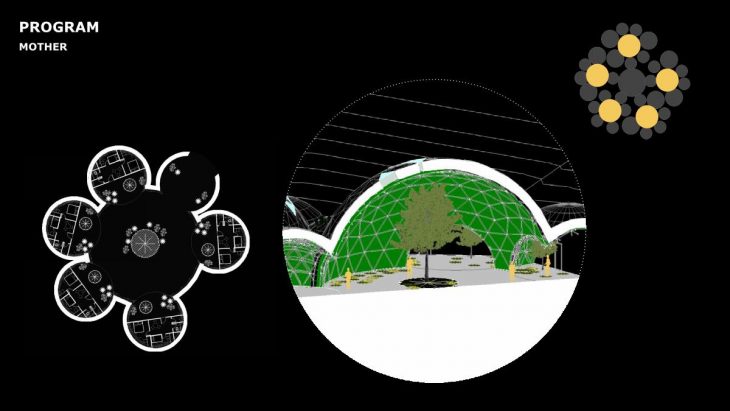
The mother will provide a common area joining the residential spaces around it.
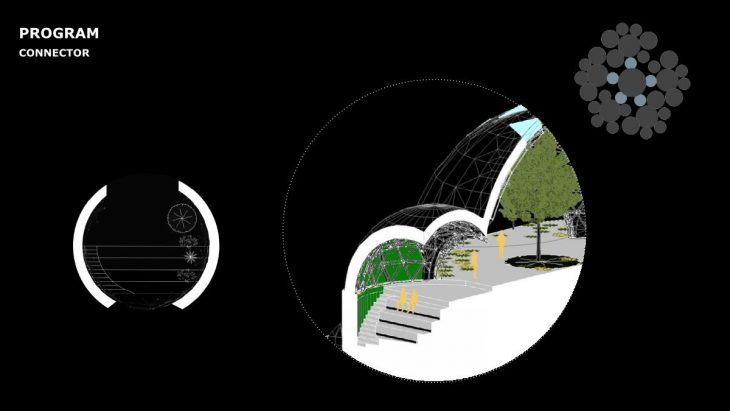
The connector module will cover circulation as well as provide additional common areas.

The residential units, first the bigger one, accommodating a bigger family
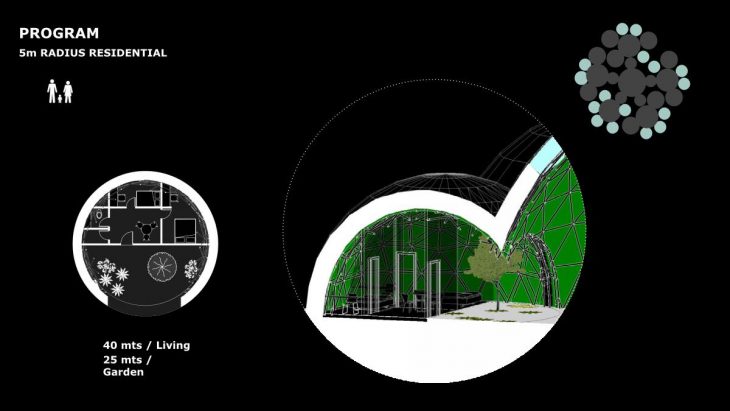
And then the smaller unit provides space for a smaller family.
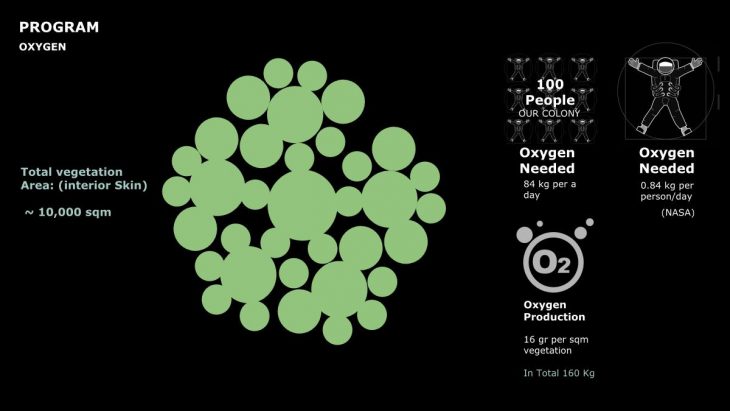
In the colony out of 100 people, we will need 84 kg of oxygen per day and with the 10.000 square meters of interior vegetal skin, we will produce 160 kg per day. That means that our project could supply double of the total needed and will bring high physiological benefits to the colony.
Here we can see the step by step. The Robots will start first assembling the geodesic structure. Later we can see how the small units are connected to the mother and how the Bacteria Honeycomb panels are placed. Then the dome will be covered with regolith over the bacteria and inside the new soil will be added.
Here we can see all the layers of the system. The mothers will provide light through a Triangular Gold Coating glass that will be fixed to the Geodesic Dome
This is our computational showing the different 11 steps we went through. Starting from manipulating the Context with our massing in Grasshopper. Then developing our growth system with Python and then transferring out the different layers with Speckle and Rhino inside.
In order to give feedback to our system, we analyzed it, for example with Karamba. Finally, Revit was used to receive all the streams and to document the project.
As well in this process was really important to create a collaborative workflow within our group of 2 Architects and 1 Ingenieur.
Here you can see an example of how the Roles are reflected in the different systems of the project, such as the structure, Bacteria layer, or walls.
//DOCUMENTATION
Here we are cutting horizontally our project showing the 4 levels that were created in order to adapt to the specific terrain conditions. We can also see how the bacteria layer was integrated along with the project.
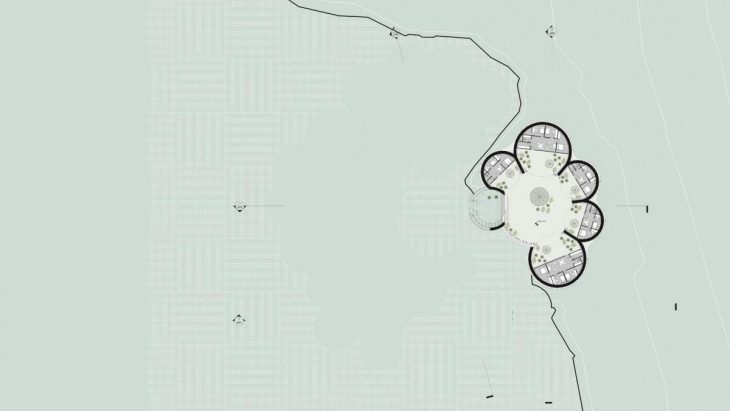
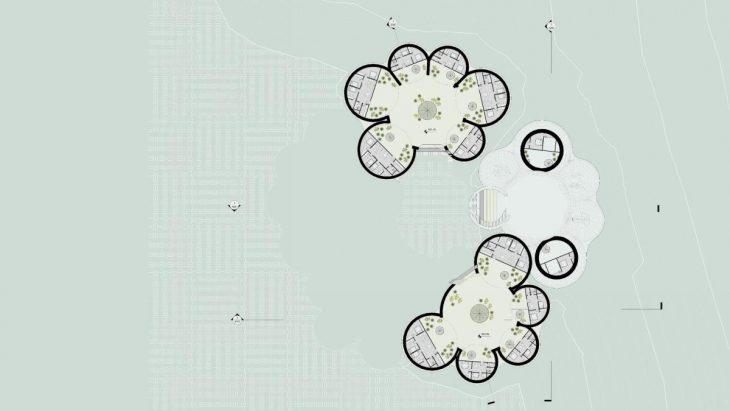
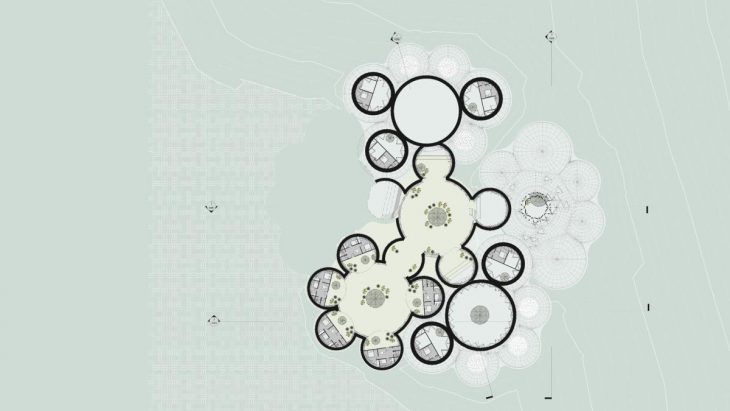
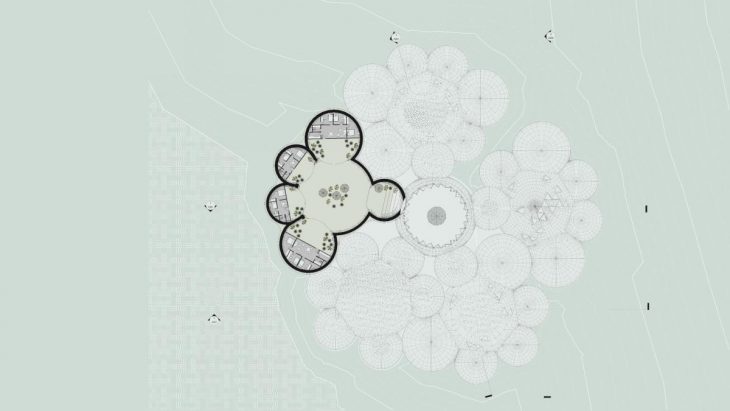
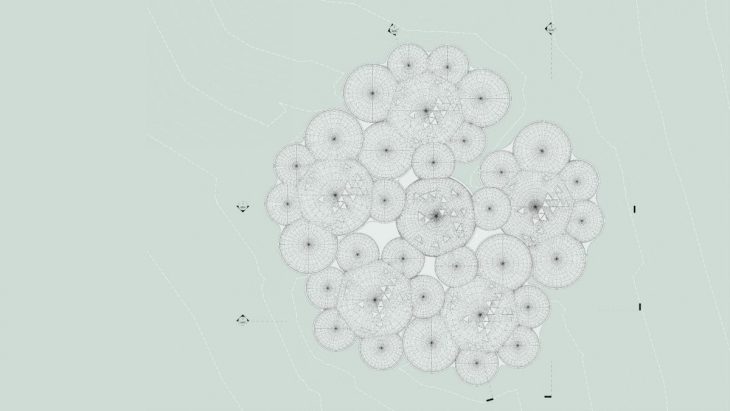
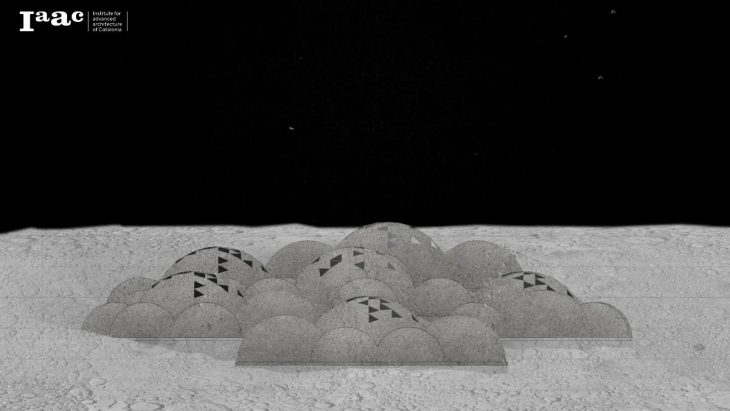
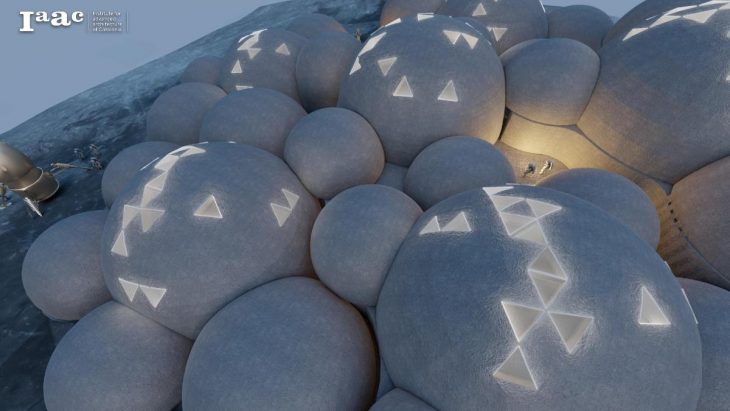
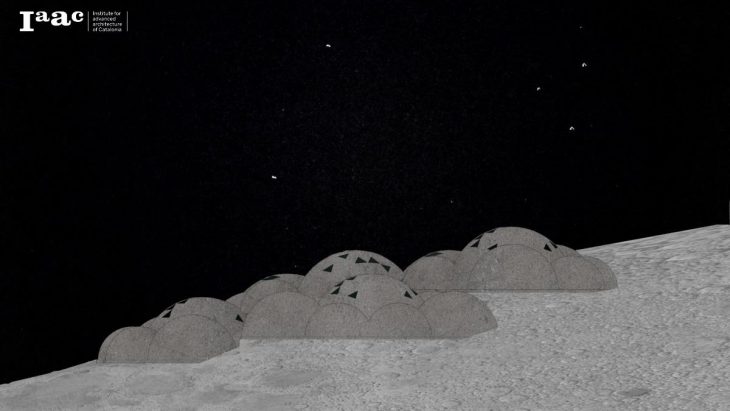
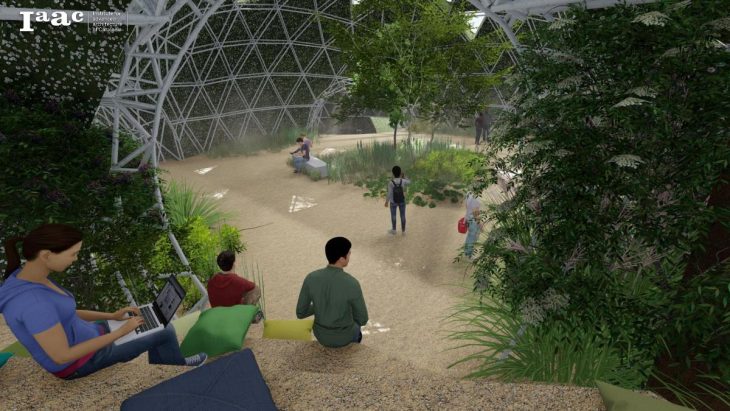
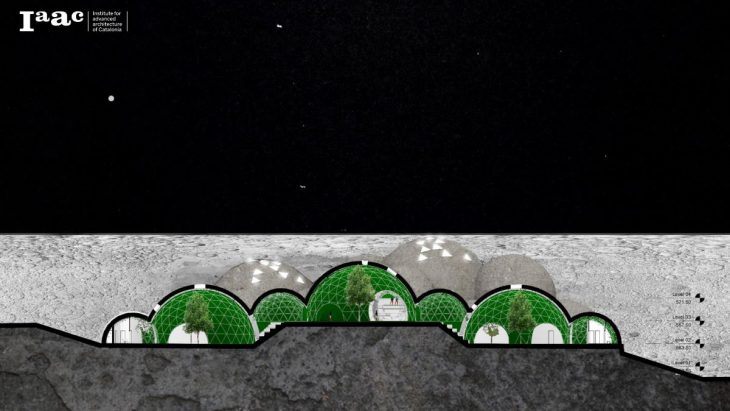
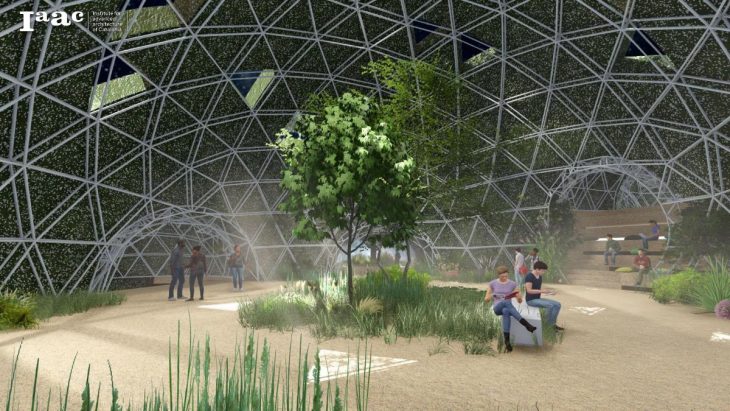
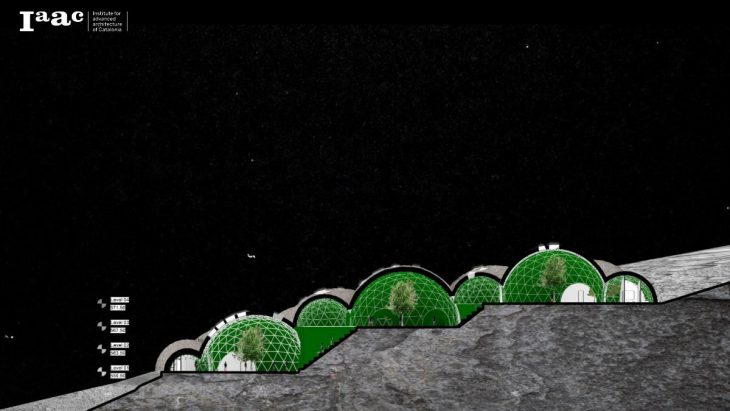
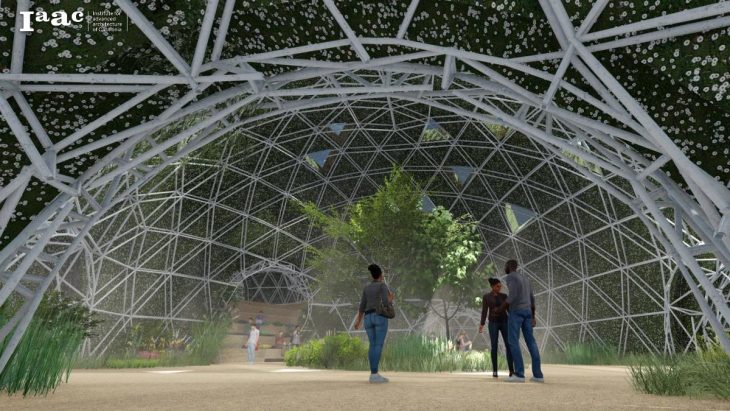
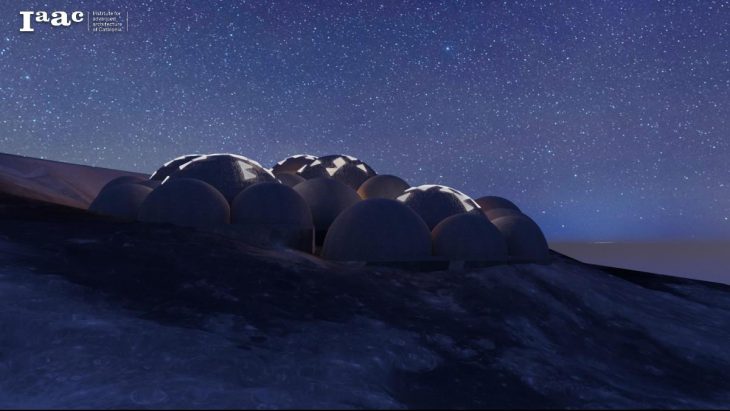
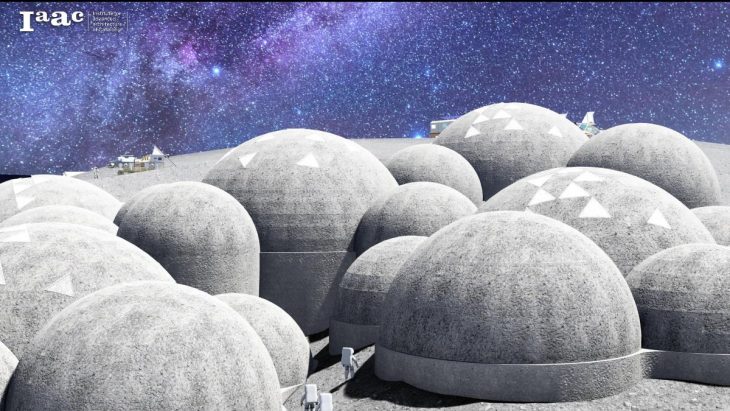
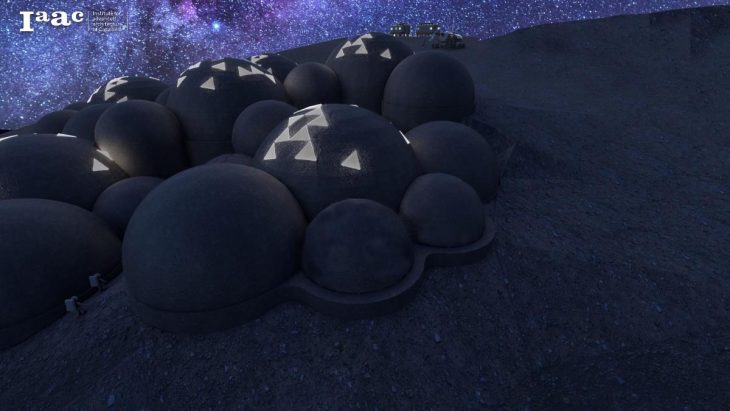
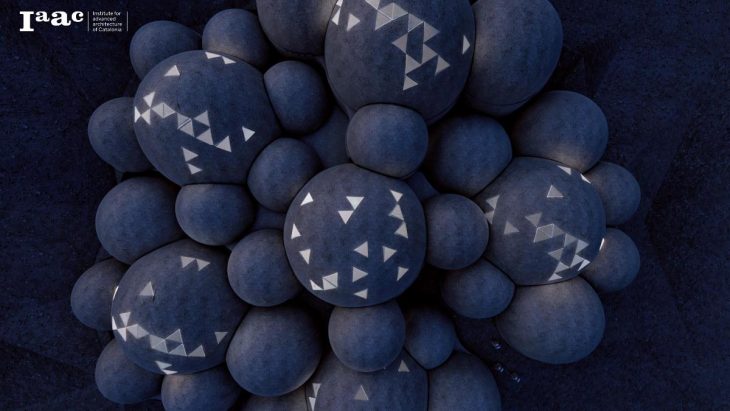
Seleno Bio-Habitat is a project of IAAC, Institute for Advanced Architecture of Catalonia developed at
Master in Advanced Computation for Architecture & Design – MaCAD in 2021 by students: Aleksandra Jastrz?bska, Abed E. Badran, Jonathan Hernández López and faculty: David Andres Leon & Oana Taut.
